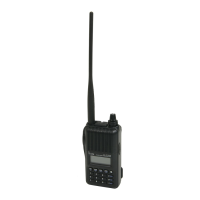New2001
23
4
BASIC OPERATION
New2001
■ Transmitting
NOTE: To prevent interference, push and hold [MONI]
(BAND) to listen on the frequency before transmitting.
q Set the operating frequency. (p. 20)
•Youcantransmitonthe144 MHz/440
MHz amateur bands only.
•Selectthedesiredoutputpower.See
the previous page for details.
w Push and hold [PTT] to transmit.
•“
” appears.
•The S/RF meter shows the output
power level.
e Speak into the microphone using
your normal voice level.
•DONOTholdthetransceivertooclose
to your mouth or speak too loudly. This
may distort your speech.
r Release [PTT] to return to receive.
R WARNING! NEVER transmit for long periods of time.
When the transceiver is used for prolonged transmissions
at high power or middle power, the transceiver radiates heat
to protect itself from overheating. The transceiver’s chassis
will become hot and may cause a burn.
• To prevent the transceiver’s overheating, the default setting of
the time-out timer function is set to 5 minutes (p. 62). Be careful
when the time-out timer function is turned OFF or set to a long
time period, and transmission is made for long periods.
DO NOT operate the transceiver in a situation that will ob-
struct heat dissipation, especially if the transceiver is oper-
ated with an external power supply. Heat dissipation may
be affected, and it may cause a burn, warp the casing or
damage the transceiver.
NOTE: When the transceiver becomes hot from continuous
transmission, etc., the transceiver’s heat protection function
gradually reduces the output power to 2.5 W (Mid), then
it stops transmission after that. This is done to protect the
transceiver itself until it has cooled down.
•“M”(Powericon)blinkswhile the heat protection function reduces
the output power.
•“Hot”isdisplayedwhile the heat protection function inhibits trans-
mission.
While using the battery case:
Frequent or continuous transmissions can cause the batteries
to overheat. To prevent this, we recommend using the middle or
low power settings.
CAUTION: Transmitting without an antenna will damage the
transceiver.

